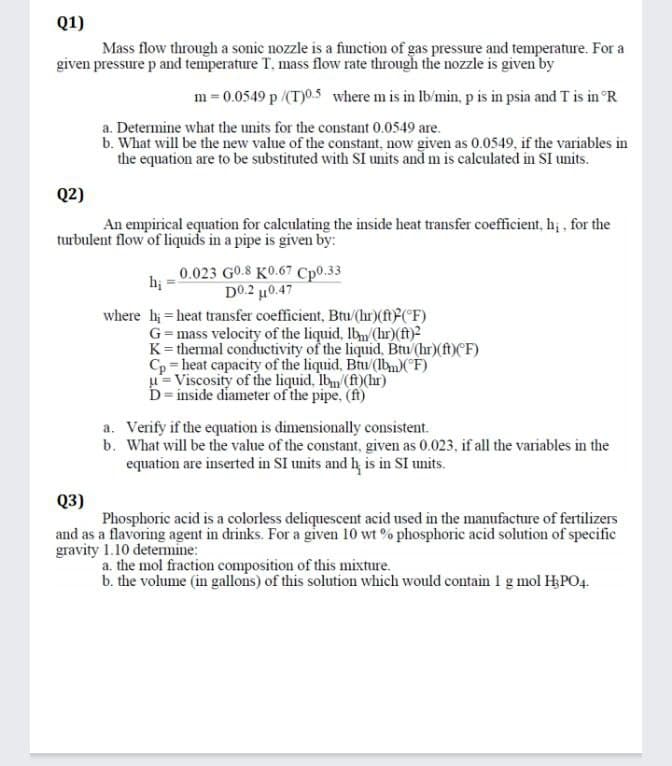Mass flow through a sonic nozzle is a function of gas pressure and temperature. For a given pressure p and temperature T, mass flow rate through the nozzle is given by m = 0.0549 p /(T)0.5 where m is in Ib'min, p is in psia and T is in °R a. Determine what the units for the constant 0.0549 are. b. What will be the new value of the constant, now given as 0.0549, if the variables in the equation are to be substituted with SI units and m is calculated in SI units.
Mass flow through a sonic nozzle is a function of gas pressure and temperature. For a given pressure p and temperature T, mass flow rate through the nozzle is given by m = 0.0549 p /(T)0.5 where m is in Ib'min, p is in psia and T is in °R a. Determine what the units for the constant 0.0549 are. b. What will be the new value of the constant, now given as 0.0549, if the variables in the equation are to be substituted with SI units and m is calculated in SI units.
Chemistry
10th Edition
ISBN:9781305957404
Author:Steven S. Zumdahl, Susan A. Zumdahl, Donald J. DeCoste
Publisher:Steven S. Zumdahl, Susan A. Zumdahl, Donald J. DeCoste
Chapter1: Chemical Foundations
Section: Chapter Questions
Problem 1RQ: Define and explain the differences between the following terms. a. law and theory b. theory and...
Related questions
Question

Transcribed Image Text:Q1)
Mass flow through a sonic nozzle is a function of gas pressure and temperature. For a
given pressure p and temperature T, mass flow rate through the nozzle is given by
m = 0.0549 p /(T)0.5 where m is in Ib/min, p is in psia and T is in °R
a. Determine what the units for the constant 0.0549 are.
b. What will be the new value of the constant, now given as 0.0549, if the variables in
the equation are to be substituted with SI units and m is calculated in SI units.
Q2)
An empirical equation for calculating the inside heat transfer coefficient, h; , for the
turbulent flow of liquids in a pipe is given by:
0.023 GO.8 K0.67 Cp0.33
hi
D0.2 µ0.47
where hi = heat transfer coefficient, Btu/(hr)(ft("F)
G=mass velocity of the liquid, lbm/(hr)(ft)?
K = thermal conductivity of the liquid, Btu (hr)(ft)(F)
Cp = heat capacity of the liquid, Biu(lbm)(F)
u= Viscosity of the liquid, Ib/(ft)(hr)"
D= inside diameter of the pipe, (ft)
a. Verify if the equation is dimensionally consistent.
b. What will be the value of the constant, given as 0.023, if all the variables in the
equation are inserted in SI units and h is in SI units.
Q3)
Phosphoric acid is a colorless deliquescent acid used in the manufacture of fertilizers
and as a flavoring agent in drinks. For a given 10 wt % phosphoric acid solution of specific
gravity 1.10 detemine:
a. the mol fraction composition of this mixture.
b. the volume (in gallons) of this solution which would contain 1 g mol HPO4.
Expert Solution
This question has been solved!
Explore an expertly crafted, step-by-step solution for a thorough understanding of key concepts.
This is a popular solution!
Trending now
This is a popular solution!
Step by step
Solved in 3 steps with 3 images

Knowledge Booster
Learn more about
Need a deep-dive on the concept behind this application? Look no further. Learn more about this topic, chemistry and related others by exploring similar questions and additional content below.Recommended textbooks for you

Chemistry
Chemistry
ISBN:
9781305957404
Author:
Steven S. Zumdahl, Susan A. Zumdahl, Donald J. DeCoste
Publisher:
Cengage Learning

Chemistry
Chemistry
ISBN:
9781259911156
Author:
Raymond Chang Dr., Jason Overby Professor
Publisher:
McGraw-Hill Education

Principles of Instrumental Analysis
Chemistry
ISBN:
9781305577213
Author:
Douglas A. Skoog, F. James Holler, Stanley R. Crouch
Publisher:
Cengage Learning

Chemistry
Chemistry
ISBN:
9781305957404
Author:
Steven S. Zumdahl, Susan A. Zumdahl, Donald J. DeCoste
Publisher:
Cengage Learning

Chemistry
Chemistry
ISBN:
9781259911156
Author:
Raymond Chang Dr., Jason Overby Professor
Publisher:
McGraw-Hill Education

Principles of Instrumental Analysis
Chemistry
ISBN:
9781305577213
Author:
Douglas A. Skoog, F. James Holler, Stanley R. Crouch
Publisher:
Cengage Learning

Organic Chemistry
Chemistry
ISBN:
9780078021558
Author:
Janice Gorzynski Smith Dr.
Publisher:
McGraw-Hill Education

Chemistry: Principles and Reactions
Chemistry
ISBN:
9781305079373
Author:
William L. Masterton, Cecile N. Hurley
Publisher:
Cengage Learning

Elementary Principles of Chemical Processes, Bind…
Chemistry
ISBN:
9781118431221
Author:
Richard M. Felder, Ronald W. Rousseau, Lisa G. Bullard
Publisher:
WILEY